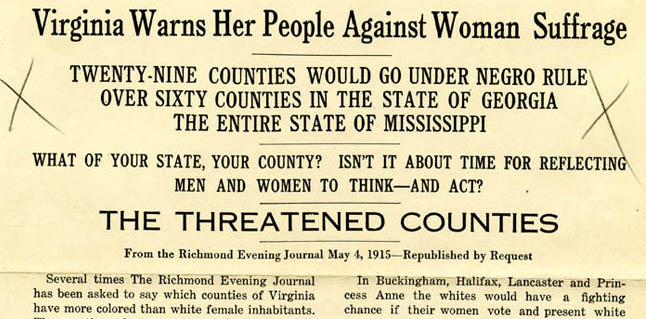The Politics of Suffrage and Race.
Opponents of a federal suffrage amendment argued that its passage risked
the provisions passed in the 1901-02
state constitution that kept blacks from voting—e.g.
a poll tax, and literacy and residency
requirements. They further argued that allowing women the vote would lead
to a flood of black female votes, upsetting the white supremacy then in place in the courts and
legislature. Such views are starkly demonstrated in this article first published in the
Richmond Evening Journal on May 4, 1915.
Early on, the ESL publicly ignored the race issue. But by 1917, it began to counter
fears over possible increases in black voters by averring that all literacy, residency, and poll tax requirements in the state constitution would apply to women,
and hence prevent
African-American women from voting, as it did with African American
men. These lines of argument
essentially silenced the voices of African-American
women, as well as many poor and lower class white women
in the public debate.
Black women worked hard separately from whites to enfranchise themselves,
particularly after passage of the federal amendment in 1920. Registration drives
led to 2,410 black women registering in Richmond for the 1920 elections.
Activists such as Maggie Walker and Ora Brown Stokes petitioned
Richmond officials to provide more employees to assist black
women in registering. When excluded in 1920 from the all-white League of Women Voters of
Virginia (a decision for which Adèle Goodman Clark later expressed regret), black
women established the Virginia Negro Women’s League of Voters, and continued to work for
increased registration.


